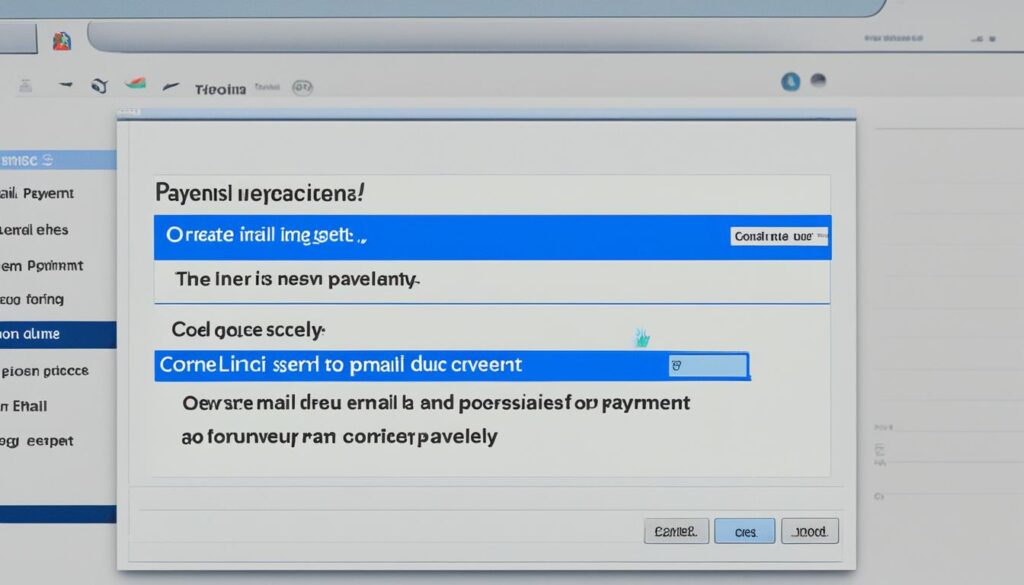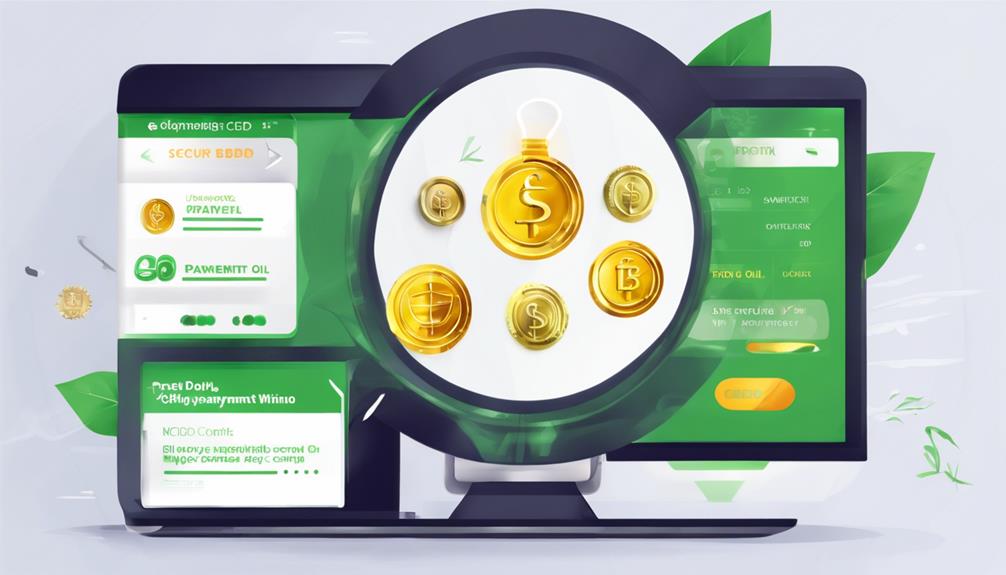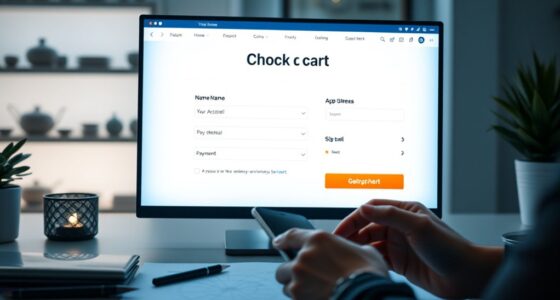Did you know that more than 60% of freelancers have experienced delayed payments at some point in their careers? If you’re tired of waiting for clients to pay up, it’s time to take charge and learn effective and polite ways to ask for payment. In this article, I will share useful tips and templates to help you collect overdue payments without damaging your professional relationships. Let’s begin!
Key Takeaways:
- Over 60% of freelancers have experienced late payments.
- Learn effective and polite strategies for demanding payment.
- Use templates and tips to collect overdue payments.
Overcoming the Fear of Asking for Payment
Many people feel uncomfortable discussing finances and avoid talking about money. This is often because we tie our self-worth to our material possessions and have never been taught how to navigate money talk. However, by weighing the pros and cons of asking for payment and understanding the value of your work, you can overcome the fear and gain confidence in asking for what you deserve.
When it comes to discussing payment, it’s important to separate your self-worth from the monetary value of your work. Remember that requesting payment is a standard business practice that ensures you receive fair compensation for your skills and efforts. By valuing your time and expertise, you can shift your mindset and approach money conversations with confidence.
Instead of avoiding money discussions, embrace them as an opportunity to assert your worth and reinforce your professionalism. Recognize that asking for payment is not impolite or pushy, but an essential part of conducting business. By reframing your mindset and understanding the value of your work, you can overcome the fear and hesitation associated with asking for payment.
Additionally, preparing yourself with the necessary tools and information can boost your confidence in discussing finances. Keep track of your work, payments, and expenses in an organized manner. Calculate your rates and determine your worth based on market standards and the quality of your services. Having these details at hand will help you approach payment discussions with clarity and conviction.
Remember, you deserve to be compensated for your hard work and expertise. By detaching your self-worth from the fear of asking for payment, you can confidently advocate for yourself and establish a healthy relationship with your finances.
Image:
| Benefits of Overcoming the Fear of Asking for Payment | Consequences of Avoiding Money Conversations |
|---|---|
|
|
Timing is Key: When to Ask for Payment
When it comes to asking for payment, timing is everything. To ensure prompt payment, it’s important to issue your invoice promptly and establish a clear schedule for sending payment reminders. Here’s a breakdown of the best practices:
Issue Your Invoice Promptly
As soon as you complete a project or deliver your goods, it’s essential to send your invoice promptly. By doing so, you set a professional tone and demonstrate your expectation for timely payment. Include all relevant payment details, such as payment due date, accepted payment methods, and any late payment penalties.
Send Payment Reminders Before the Due Date
In order to avoid late payments, it’s a good practice to send friendly payment reminders a few days before the payment due date. This serves as a gentle nudge to your client and helps them prioritize your payment. You can send a polite email reminding them of the upcoming due date and include a link to the invoice for easy access.
Follow Up After the Payment Due Date
If the payment due date has passed without receiving payment, it’s time to send another reminder. This follow-up email should be firm yet professional, conveying the importance of timely payment and any consequences of late payment. At this point, you can consider attaching a copy of the original invoice and reiterating the payment details.
“Sending reminders and following up on late payments allows you to maintain control over your cash flow and ensures that your clients prioritize your payment.”
Establish a Regular Schedule of Payment Reminders
To stay on top of your payment collection process, it’s beneficial to establish a regular schedule for sending payment reminders. This could include sending a reminder a few days before the due date, a follow-up reminder a week after the due date, and a final notice if the payment remains outstanding. Consistency in your communication demonstrates your professionalism and emphasizes the importance of timely payment.
Utilize Payment Reminders and Invoicing Software
To streamline your payment process and ensure timely reminders, consider utilizing payment reminders and invoicing software. Many platforms offer automated reminders and customizable templates for emails and invoices. This not only saves you time but also increases the chances of prompt payment.
| Benefits of Payment Reminders and Invoicing Software | Examples of Software |
|---|---|
| Automated payment reminders | PayPal, QuickBooks |
| Customizable email templates | Xero, FreshBooks |
| Efficient payment tracking | Zoho Invoice, Wave |
| Integration with payment processors | Stripe, Square |

By following these timing strategies, you can maintain a professional approach to requesting payment and encourage your clients to value your work and meet their payment obligations. Remember, a proactive and organized approach to payment collection can significantly improve your cash flow and contribute to a successful business.
How to Ask for Payment Politely via Email
When it comes to requesting payment, sending a polite and informative email can make all the difference. By maintaining a professional tone and including a clear call to action, you can increase the chances of prompt payment. Here are some tips for crafting a payment request email that is effective and professional:
1. Start with a Polite Greeting
Begin your email by addressing your client with a polite greeting. Use their name and a friendly tone to establish a positive and professional atmosphere.
2. State the Purpose Clearly
Clearly state the purpose of your email in the subject line and opening paragraph. Make it explicit that you are requesting payment for your services or products.
3. Provide Detailed Payment Information
In your email, include all relevant payment details such as the invoice number, payment amount, and due date. This makes it easy for your client to process the payment without any confusion.
4. Set a Clear Deadline
Emphasize the importance of timely payment by setting a clear deadline. This helps create a sense of urgency and encourages your client to prioritize the payment.
5. Use a Polite and Informative Tone
Throughout your email, maintain a polite and informative tone. Avoid using aggressive or confrontational language, as it may strain your professional relationship. Instead, focus on providing the necessary information in a clear and concise manner.
“Dear [Client’s Name],
I trust this email finds you well. I’m writing to kindly request payment for the outstanding invoice [Invoice Number]. The payment amount of [Payment Amount] is due by [Due Date].”
“To ensure a smooth transaction, please find the payment details below:
- Invoice Number: [Invoice Number]
- Payment Amount: [Payment Amount]
- Due Date: [Due Date]
“If you have any questions or need further clarification, please don’t hesitate to reach out. I appreciate your prompt attention to this matter and look forward to your payment by the deadline.”
Best regards,
[Your Name]”
6. Include a Call to Action
End your email with a clear call to action. This can be a simple request for the client to process the payment or a polite reminder to contact you if they have any questions or concerns.
7. Follow Up Appropriately
If the payment is not received by the due date, it’s important to follow up with a polite reminder. You can send a friendly email or consider contacting your client via phone to discuss the payment further.
8. Stay Professional and Persistent
Throughout the payment process, maintain a professional and persistent approach. Keep all communication polite and focused on resolving the outstanding payment. In case of non-response, consider escalating the matter through appropriate channels.

By sending a well-crafted payment request email, you can effectively communicate your need for prompt payment while maintaining a professional relationship with your client.
Polite Payment Request Email Templates
When it comes to requesting payment via email, finding the right words can make all the difference. To assist you in phrasing your payment request emails in a polite and professional manner, I have prepared six email templates that you can download and customize to suit your specific needs. These templates will serve as a helpful guide to effectively communicate your payment expectations to your clients.
The first email is the most important, as it sets the tone for the entire payment process. In this initial email, you should include all necessary information such as the invoice details, payment due date, and payment instructions. By providing your clients with a clear overview of their financial obligations, you establish a foundation for a smooth payment process. Remember to maintain a polite and friendly tone throughout the email.
Example Payment Request Email
Dear [Client Name],
I hope this email finds you well. I wanted to reach out regarding the recent services I provided for you. Attached to this email, you will find the invoice for the work completed, totaling $[Amount]. The payment is due on [Due Date].
I greatly value our working relationship and place a high priority on excellent customer service. With that said, I kindly request that you submit the payment as soon as possible. Prompt payment ensures that I can continue to deliver exceptional work and meet your needs effectively.
Please find the necessary payment details below:
- Payment method: [Preferred payment method]
- Account name: [Your name or company name]
- Account number: [Your account number]
- Routing number: [Your routing number]
If you have any questions or require further assistance, please don’t hesitate to reach out. I am more than happy to provide clarification or discuss alternate payment options.
Thank you for your attention to this matter, and I look forward to receiving your payment soon. It is a pleasure working with you.
Best regards,
[Your Name]
Subsequent emails can serve as friendly reminders to ensure timely payments. It’s important to maintain professionalism while gently ensuring that the invoice is not overlooked or forgotten by your client. The tone of these follow-up emails should be polite and supportive, providing a gentle nudge to encourage prompt payment.
Using these email templates as a reference, you can effectively communicate your payment expectations and increase the likelihood of receiving timely payments while fostering positive client relationships.
| Template | Purpose |
|---|---|
| “First Invoice Email” | To send the initial invoice with payment details and due date. |
| “Friendly Reminder Email” | To gently remind clients about an upcoming or overdue payment. |
| “Second Reminder Email” | To kindly follow up on late payments and highlight the importance of timely payment. |
| “Payment Plan Email” | To propose a payment plan for clients experiencing financial difficulties. |
| “Thank You for Payment Email” | To express gratitude and acknowledge receipt of payment. |
| “Final Notice Email” | To firmly request payment before taking further action. |
Asking for Payment Over the Phone
If email communication is not getting the desired response, you can consider asking for payment over the phone. Phone calls are harder to ignore and allow for a more direct conversation. When calling your client, introduce yourself, state the purpose of your call, and remain calm and clear in your communication. This direct approach can help resolve payment issues more effectively.
Direct communication through phone calls can be a powerful tool when it comes to resolving payment issues. It allows for real-time conversation, providing you with an opportunity to address any concerns or questions your client may have. By engaging in direct communication, you can build a stronger connection and ultimately increase the chances of receiving prompt payment.
When making a payment request over the phone, it’s important to follow a few key steps to ensure a successful outcome:
- Introduce yourself: Begin the conversation by introducing yourself and reminding the client of your professional relationship. This establishes credibility and sets the tone for a productive discussion.
- State the purpose: Clearly explain the purpose of your call, which is to discuss and request payment for the outstanding invoice. Be concise and to the point, emphasizing the importance of timely payment.
- Remain calm and clear: Throughout the conversation, maintain a calm and professional demeanor. Clearly communicate the payment details, including the amount owed, due date, and payment methods accepted. Answer any questions the client may have and address any concerns promptly.
- Listen actively: Be attentive to your client’s responses and actively listen to their concerns. Showing empathy and understanding can go a long way in resolving any payment issues or misunderstandings.
- Negotiate if necessary: In some cases, your client may express difficulties in making the full payment. Use this opportunity to discuss alternative payment arrangements or negotiate a reasonable payment plan that works for both parties.
- Follow up in writing: After the phone call, it’s essential to send a follow-up email summarizing the details discussed during the conversation. This serves as a written confirmation of your conversation and provides a reference for both parties.
By incorporating phone calls into your payment collection strategy, you can demonstrate your commitment to resolving payment issues and create a sense of urgency for your clients. Remember to maintain professionalism, stay organized, and follow up diligently to ensure a successful outcome.

Dealing with Late Payments
In some cases, clients may need a gentle reminder about overdue invoices. Sending a late payment reminder email is a professional way to follow up on outstanding invoices. You should reiterate the invoice details, payment terms, and include a clear call to action. The tone should remain friendly and informative, emphasizing the importance of timely payment and the consequences of non-payment.
When sending a late payment reminder email, it’s important to maintain a friendly and informative tone. Start the email by politely addressing the client and reminding them of the outstanding invoice. Be sure to include the invoice details, such as the invoice number, date, and amount owed.
Emphasize the importance of timely payment in the email and explain the consequences of non-payment, such as late fees or suspension of services. Clearly state the revised due date and provide convenient payment options, such as online payment portals or bank transfer details.
Here’s an example of how you can structure a late payment reminder email:
Hi [Client’s Name],
I hope this email finds you well. I wanted to bring to your attention that we have not yet received payment for Invoice [Invoice Number] due on [Due Date]. I kindly request that you settle the outstanding amount of [Amount Due] at your earliest convenience.
As a valued client, we want to ensure that we continue to provide our services to you smoothly. Therefore, I kindly ask that you make the payment as soon as possible to avoid any further delays in our business relationship.
For your convenience, we have attached the invoice for your reference. You can make the payment via [Payment Method] by [Revised Due Date]. If you have any questions or need further assistance, please don’t hesitate to reach out to me.
Thank you for your prompt attention to this matter. We greatly appreciate your continued support.
Best regards,
[Your Name]
Remember, the key to a late payment reminder email is to be polite, clear, and concise. By taking a friendly and informative approach, you increase the chances of receiving prompt payment while maintaining a positive business relationship.
When Follow-Up Emails Don’t Work
If your follow-up emails and phone calls are met with no response or payment, it may be time to consider more assertive measures to ensure you receive the payment you deserve. While maintaining professionalism is key, sometimes you need to take decisive action to resolve the issue.
One option you can consider is cutting off future work until the outstanding payments are resolved. By clearly communicating that future projects are contingent upon timely payments, you create a sense of urgency and emphasize the importance of fulfilling financial obligations.
Another approach is seeking the assistance of a collection agency. These agencies specialize in recovering debts and have the expertise to navigate the legal aspects of the process. They can pursue unpaid invoices on your behalf, increasing the chances of receiving payment.
However, legal action should be considered a last resort due to its potential costs and complexities. It is advisable to consult with a lawyer or legal professional to understand the relevant laws and regulations in your jurisdiction before proceeding with legal measures.
Remember, the goal is to secure the payment owed to you while also maintaining professional relationships. Before resorting to more assertive measures, exhaust all other options for communication and resolution.

Preventing Late Payments in the Future
To avoid chasing late payments in the future, it’s important to take preventative measures. By implementing the following strategies, you can minimize the likelihood of late payments and ensure a smoother payment process.
Set Clear Payment Terms
Establishing clear payment terms upfront is essential. Clearly communicate the due dates, payment methods, and any late payment penalties. This ensures that both parties are on the same page regarding payment expectations and helps prevent any misunderstandings.
Maintain Detailed Records of Your Work
Keeping detailed records of your work is crucial for accurate invoicing and payment tracking. Maintain a comprehensive record of all services rendered, including dates, descriptions, and hours worked if applicable. This documentation serves as evidence of the work performed and facilitates transparent communication with clients.
Agree on Milestone Payments
If you’re working on long-term projects, consider implementing milestone payments. Breaking down the project into smaller deliverables and invoicing accordingly ensures that you receive payment throughout the duration of the project. This not only reduces the risk of late payments but also provides a sense of progress for both you and your client.
Protect Your Work with Watermarks or Limited Access
If you provide digital assets or deliverables, consider protecting your work with watermarks or limited access. Adding watermarks to your work ensures that it cannot be used without proper payment, while granting limited access allows clients to view the work before making full payment. These measures deter unauthorized use and encourage prompt payment.

By implementing these preventive measures, you can create a professional payment process that minimizes the risk of late payments. Setting clear payment terms, maintaining detailed records, utilizing milestone payments, and protecting your work helps establish trust and ensures a smoother payment experience for both you and your clients.
Using Software for Payment Management
Managing payments can be time-consuming, but with the right software tools, you can streamline the process and ensure an efficient payment workflow. The use of online payment tools and payment management software can greatly simplify your payment tracking and help you maintain compliance with relevant regulations.
Platforms like PayPal, Payoneer, and Google Pay offer a range of features that make payment management easier. These platforms allow you to automate payment reminders, making it effortless to prompt clients for timely payments. Additionally, they provide easy payment options for your clients, ensuring a smooth and convenient payment process.
For comprehensive payment management, consider using software like Deel. Deel simplifies invoicing and payment tracking, giving you complete visibility into your payment status and history. The platform also ensures compliance with regulations, helping you stay on top of tax requirements and other financial obligations.
With these software tools, you can streamline your payment process, reduce manual effort, and ensure that your payment management is efficient and compliant.

| Software Tool | Features |
|---|---|
| PayPal |
|
| Payoneer |
|
| Google Pay |
|
Overcoming Challenges in Getting Paid
Despite my best efforts, there may still be challenges in getting paid. In such cases, you can consider hiring a collection agency to help collect overdue payments or take legal action to recover the funds owed to you. However, persistence and clear communication should be your first approaches, exhausting all other options before resorting to further measures.
“When facing difficulties in receiving payment, it’s crucial to remain persistent and tackle the issue head-on. By exploring different strategies and maintaining open lines of communication, you can increase your chances of getting paid.”
– Jane Smith, Freelancer
Persistence is Key
When dealing with non-payment, it can be frustrating and discouraging. However, persisting in demanding payment can yield positive results. Stay proactive and maintain regular follow-ups with your client, reminding them politely of the outstanding payment and the consequences of non-payment.
Using Collection Agencies
If your attempts to collect payment directly have been unsuccessful, it may be time to involve a collection agency. These agencies specialize in recovering funds from delinquent clients and have the expertise and resources to handle such situations. However, it’s important to research and choose a reputable agency that adheres to legal and ethical practices.
Legal Action as a Last Resort
While taking legal action should be a last resort, it may be necessary in certain situations to ensure payment. Consult with an attorney to understand the legal options available to you and the potential outcomes. This step should only be taken after exhausting all other options, as legal proceedings can be time-consuming and costly.
| Advantages of Hiring a Collection Agency | Considerations for Legal Action |
|---|---|
|
|
Key Takeaways
- Persistence and clear communication are essential in demanding payment.
- Consider utilizing the services of a collection agency to recover overdue payments.
- Legal action should be a last resort after exhausting all other options.

Ensuring Professionalism in Payment Requests
When it comes to requesting payment for your work, it’s essential to maintain professionalism to uphold positive client relationships. Displaying professionalism in your payment requests demonstrates your commitment to delivering high-quality services while fostering a respectful and amicable working environment. To ensure that your payment requests are handled with decorum, follow these key guidelines:
1. Keep it Professional:
When requesting payment, avoid making the conversation personal or sharing personal financial circumstances. Instead, maintain a professional tone by focusing solely on the transaction and the services provided.
2. Clear and Concise Communication:
Ensure your payment requests are easy to understand and concise. Clearly state the amount due, payment terms, and any specific instructions. By providing all the necessary information, you help facilitate timely and accurate payments.
3. Use Polite and Friendly Language:
While it’s important to be direct, it’s also crucial to maintain kindness and friendliness in your communication. Phrases such as “Thank you for your attention to this matter” or “I appreciate your prompt response” can add a personal touch while remaining professional.
4. Offer Convenience:
Make it as easy as possible for your clients to make payments. Provide multiple payment options and include clear instructions on how to complete the transaction. This will help streamline the payment process and minimize any potential delays.
5. Follow Up Promptly:
If a payment deadline has passed, politely follow up with a friendly reminder. Use phrases like “Just a friendly reminder that the payment was due on [date].” This approach shows professionalism and encourages clients to prioritize and address any outstanding payments.
“Maintaining professionalism in payment requests strengthens your reputation as a reliable and trustworthy professional while ensuring long-lasting client relationships.”
6. Keep Records:
Keep detailed records of all communication related to payment requests. This includes copies of invoices, email exchanges, and any additional documents involved. Having organized records helps provide clarity and evidence should any issues or disputes arise.
7. Provide Regular Updates:
If there are any changes in payment terms or if there are delays or technical issues, promptly inform your clients. Offering transparency and proactive communication shows your professionalism and commitment to resolving any payment-related matters.
By following these professionalism guidelines, you can effectively navigate payment requests while maintaining strong client relationships. Remember, remaining calm, courteous, and professional throughout the payment process contributes to a positive and productive working environment for both parties involved.

Conclusion
In conclusion, effective payment demand tactics require a balance of politeness and assertiveness. By overcoming the fear of asking for payment and following appropriate timing, you can increase the chances of prompt payment.
Using polite and informative communication methods, such as emails or phone calls, allows you to maintain professionalism while making your payment requests. Additionally, taking preventative measures, like setting clear payment terms and using payment management software, can help prevent late payments in the future.
However, in cases of non-payment, it is important to consider professional escalation options, while still maintaining professionalism and clear communication. Remember, persistence is key in getting paid on time, so don’t hesitate to follow up on outstanding invoices.
FAQ
When should I ask for payment?
How should I ask for payment via email?
Are there templates I can use for payment request emails?
Should I consider asking for payment over the phone?
How can I follow up on outstanding invoices?
What should I do if follow-up emails and phone calls don’t work?
How can I prevent late payments in the future?
Are there software tools available to streamline payment management?
What can I do if I have challenges in getting paid?
How can I ensure professionalism in my payment requests?
How Can Polite Payment Demand Tactics Help in Navigating Finances and Finding Payment Easily?
When dealing with overdue payments, employing polite payment demand tactics can be beneficial in finding payment solutions easily. By using respectful and tactful communication, you can navigate your finances effectively and increase the likelihood of receiving payments in a timely manner.









